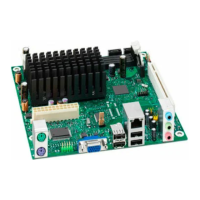Technical Reference
57
2.7 Power Consumption
Power measurements were performed to determine bare minimum and likely
maximum power requirements from the board, as well as attached devices, in order to
facilitate power supply rating estimates for specific system configurations.
2.7.1 Minimum Load Configuration
Minimum load refers to the power demand placed on the power supply when using a
bare system configuration with minimal power requirement conditions. Minimum load
configuration test results are shown in Table 26. The test configuration was defined as
f
o
llows:
• 4 GB DDR2/667 MHz DIMM
• USB keyboard and mouse
• LAN linked at 100 Mb/s
• DOS booted via network (PXE); system at idle
• All on board peripherals enabled (serial, audio, …)
Table 26. Minimum Load Configuration Current and Power Results
Current Draw at 12 V Power Consumption
1.591 A 19.092 W
2.7.2 Maximum Load Configuration
Maximum load refers to the incremental power demands placed on the power supply,
augmenting the minimum load configuration into a fully-featured system that stresses
power consumption from all subsystems. Maximum load configuration test results are
shown in Table 27. The test configuration was defined as follows:
• 4 GB DDR2/667 MHz DIMM
• SATA DVD-R/W
⎯ Load: DVD pl
ayback
• 3.5-i
nch SATA hard disk drive, running Microsoft Windows Vista Home Basic
⎯ Load: continuous read/write benchmark
• Riser card on conventional PCI slot, populated with PCI LAN card, running file
transfer through local network to SATA hard drive
• USB keyboard and mouse
• Back and front panel host-powered USB devices (other than keyboard and mouse)
⎯ Load: continuous read/write activity on external drive/peripheral

